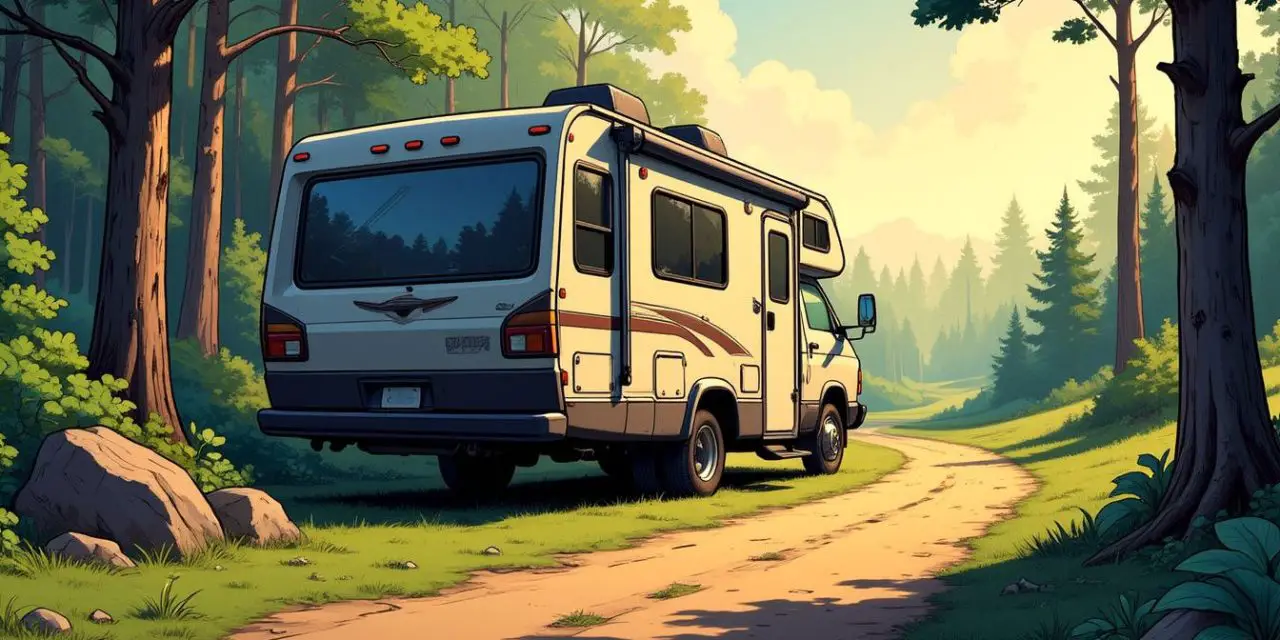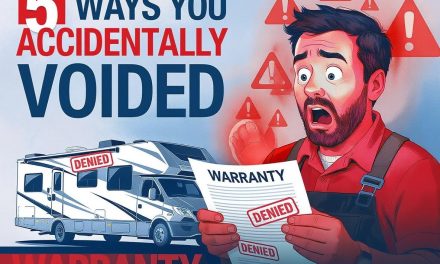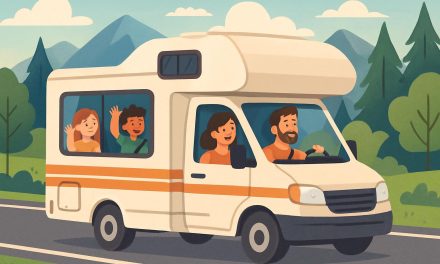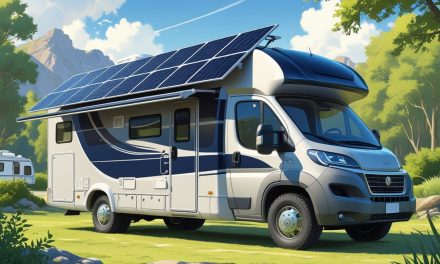Would you like to save this article?
Wondering, “Can I level my RV with the slides out“? It’s a common question for new and experienced RVers alike. Most experts agree—leveling before extending slides prevents damage to your camper.
This guide breaks down the risks, best practices, and exceptions so you can camp with confidence. Keep reading to avoid costly mistakes.
Should You Level Your RV With the Slides Out?
Leveling your RV with the slides out is a bad idea. Most RVers and forum experts agree—extending slides before leveling stresses the mechanisms. Manufacturer decals often warn against it, and unlevel slides can damage the system.
The weight of extended slides throws off balance. The RV may settle lower on the slide side, making leveling harder. Three 800-lb slides add 2,400 lbs of extra weight for jacks to handle.
Always level first. Slides operate best on a flat plane to avoid binding or uneven pressure.
Next, let’s break down the risks of ignoring this rule.
Risks of Leveling an RV With Slides Extended
Leveling your RV with slides out strains the mechanisms—gears and seals can wear faster. Uneven pressure might bend frames or cause leaks, leading to costly repairs down the road.
Use a bubble level to check stability before extending slides, and always follow your motorhome’s manual for weight limits. Ignoring these steps risks damaging landing legs or even cracking the slide-out floor over time.
Stress on slide mechanisms
Extending your RV slides before leveling puts unnecessary strain on the mechanism. LWMCGUIR, with 30+ years of RV experience, stresses that leveling first prevents excessive wear on motors and gears.
Slide-outs can weigh up to 2,400 lbs —forcing jacks to handle uneven loads if the rig isn’t flat.
The stress can twist frames or damage flooring. Always follow manufacturer decals to avoid costly repairs.
Uneven pressure risks more than just slide function—it can harm the entire RV structure.
Moving forward, potential damage to the RV goes beyond just the slide system…
Potential damage to the RV structure
Putting extra stress on slide mechanisms isn’t the sole risk—uneven leveling with slides out can also damage your RV’s structure. Extended slide weight often causes uneven pressure, which can warp your RV’s frame or floor over time if not leveled properly.
A 3/4-inch drop when slides extend, may twist the structure if not addressed. This uneven pull stresses joints, seals, and even the chassis—issues that are difficult to fix once damage occurs.
Soft ground makes the problem worse—some users use Snap Pads to prevent sinking. Stabilizing your rig before extending slides can help avoid costly structural damage in the future.
Use blocks under jacks at soft campsites, as sinking supports can quickly throw off alignment. For motorhomes or travel trailers, ignoring this can lead to hydraulic leaks—which only exacerbate the problem.
Keeping everything balanced before those large slide-outs move is crucial to protecting your RV’s structure for years of smooth camping and avoiding expensive repairs.
Uneven pressure on slide components
Leveling your RV with the slides out can strain the tracks, cables, or gears. Uneven pressure on slide components—like those in Winnebago or Thor Industries models—leads to wear and tear over time.
Some owners, report a noticeable drop (up to 1 inch) on the slide side, stressing the mechanisms.
Always level first—slides second. The manual’s not just a suggestion.
High-end motorhomes might handle slides before leveling, but most RVs need balance to avoid damage. Check your owner’s guide for specifics—some rigs even requires the engine off during slide operation.
Best Practices for Leveling Your RV
Always level your RV first—then extend the slides to avoid uneven stress on the frame and mechanisms… learn more ways to keep your rig stable and safe.
Level the RV before extending slides
Leveling your RV before extending the slides is the smartest move—period. Keeping slides retracted while leveling prevents stress on mechanisms, avoids uneven pressure, and stops structural damage.
Some RVers use Anderson roll-on levelers to lift the slide side slightly—about two inches—before extending anything. This keeps the fridge level and prevents settling.
Follow your RV manual or guidelines, and you’ll avoid binding or wear on slide parts. Level first, then deploy slides for smooth RV camping every time.
Use a reliable leveling system
A good leveling system makes RV life easier. The Ground Control 3.0 electric system, like TrailRyde uses, keeps your rig steady for weeks without needing adjustments. Some RVs—especially motorhomes—require the engine to be running during leveling, as powerboatr points out.
Stick with trusted brands, and check if your model has app controls like My Grand RV users mentioned.
Using blocks or pads under jacks on soft ground saves headaches.
Manual overrides exist for when tech fails. Anderson roll-on levelers work well for slide prep, as David_Reaves proves by lifting the slide side two inches first.
Always match your gear to your RV’s weight and terrain.
Check the RV’s manual for specific instructions
Your RV’s manual is the best source for leveling guidance.. Some high-end motorhomes, may require slides out before leveling—always check the manual for exceptions.
Most manuals say to level with slides in, then make minor adjustments after extending them. If your RV needs the engine off to operate slides, NETHERS-THOR reminds you to confirm this in the manual too.
Exceptions to the Rule
Some RVs—like those with auto-leveling systems or specific manufacturer instructions—allow leveling with slides out. Always check your owner’s manual first to confirm.
Certain Class A motorhomes and fifth wheels use reinforced slide mechanisms that handle uneven pressure better than standard models. Just be sure to follow the guidelines for your rig’s make and model.
Manufacturer-specific guidelines
Not all RVs adhere to a single standard—some luxury motorhomes have unique requirements due to their design features, such as flush-mounted slide-outs, as explained by users like Crazylegs in discussions on RV forums specifically focused on proper setup procedures for both standard and high-end models.
These models are equipped differently in terms of operational sequences required to ensure safe use without risking potential damage over time if these specifications are ignored. Experienced owners, including Logcabiny, have emphasized the importance of closely checking individual specifications for each instance instead of assuming the same rules apply universally.
Mistakes in this regard can lead to unexpected challenges, especially during trips far from home, where immediate attention and quick solutions are necessary to minimize downtime and disruptions to travel plans.
Proper preparation upfront can prevent such issues and result in smoother, more enjoyable experiences for all involved, fostering lasting memories with family and friends. Taking time to research and plan can lead to well-executed trips under optimal conditions, ensuring satisfaction and a focus on creating meaningful, positive experiences that leave a lasting impact.
Unique RV designs or systems
Some RVs break the mold—high-end motorhomes feature flush slides meant to be extended *before* leveling. These designs handle uneven pressure better than standard setups, making them exceptions to the rule.
For unique systems, TrailRyde’s electric Ground Control 3.0 keeps an RV stable for 30 days without adjustments, while Anderson roll-on levelers offer a quick fix before slide deployment.
Lippert electric jacks need manual tweaks in certain models—this quirk matters when releveling with slides out. If your rig requires the engine on for leveling but off for slides, follow those steps precisely to avoid stress on components or structure damage later on during your rv life pro adventures.
Common Mistakes to Avoid
Many RV owners skip checking their owner’s manual—big mistake. Others forget to double-check the level after extending slides, risking costly damage.
Ignoring the owner’s manual
Ignoring your RV’s owner’s manual is risky—manufacturers like Lippert include specific steps you shouldn’t skip (just ask frustrated owners).Wwrong sequences during RV leveling can bend slides…or worse (high-end models have different rules).
Miss details like shutting off engines before operating slides? That oversight strains parts fast (JayArras notes missing post-slide adjustments causes issues too).
Even small things—can mean costly repairs later…so grab that booklet first!
Forgetting to recheck the level after extending slides
Many RV owners forget to check their rig’s level after extending slides. Slides can shift the weight, causing the RV to settle unevenly—user reports show drops of 3/4–1 inch on the slide side.
Some useres keeps one side slightly higher before deploying slides, then fine-tunes afterward for balance. Without adjusting, stress builds on the slide mechanisms, risking damage over time.
Auto-level systems help, but manual checks are still crucial. If the ground is soft—releveling prevents further settling. Some RVers adjusts post-slide to keep the fridge working right.
Snap Pads reduce releveling needs, but changes in ground conditions demand fresh checks. Always follow your RV’s manual to avoid costly fixes. Keywords: RVing, motorhome, wrangler.
Conclusion
Leveling your RV with slides out isn’t ideal. It strains the slide mechanisms and risks structural damage. Always check your owner’s manual—some models might allow it, but most don’t.
Stick to leveling first, then extend the slides for a smoother setup. A little extra care now saves costly repairs later.





